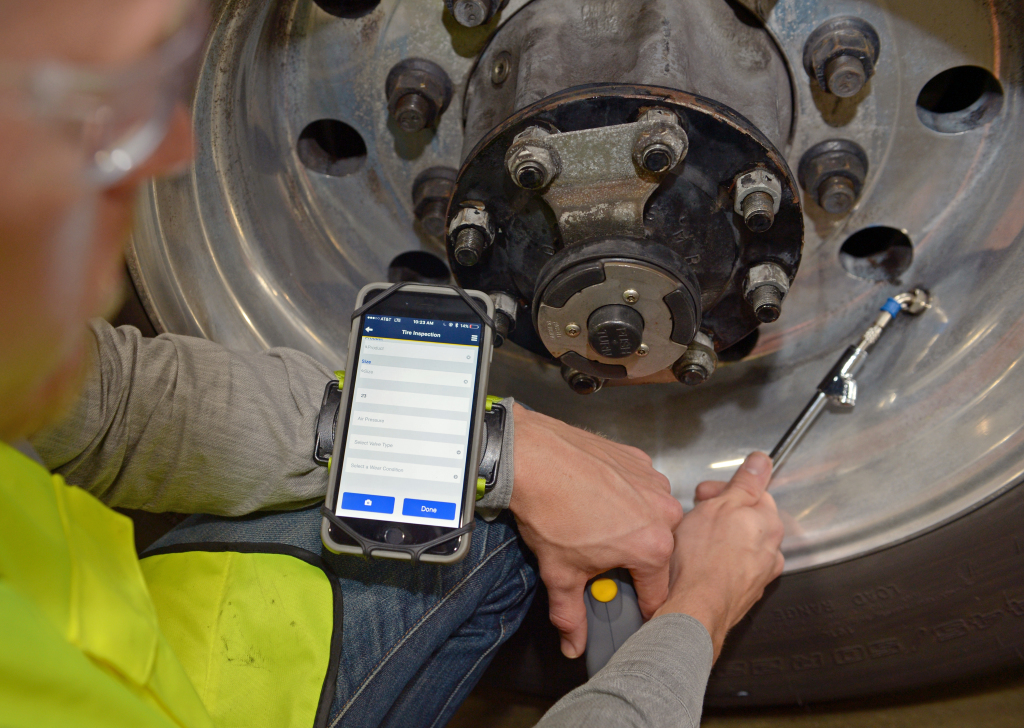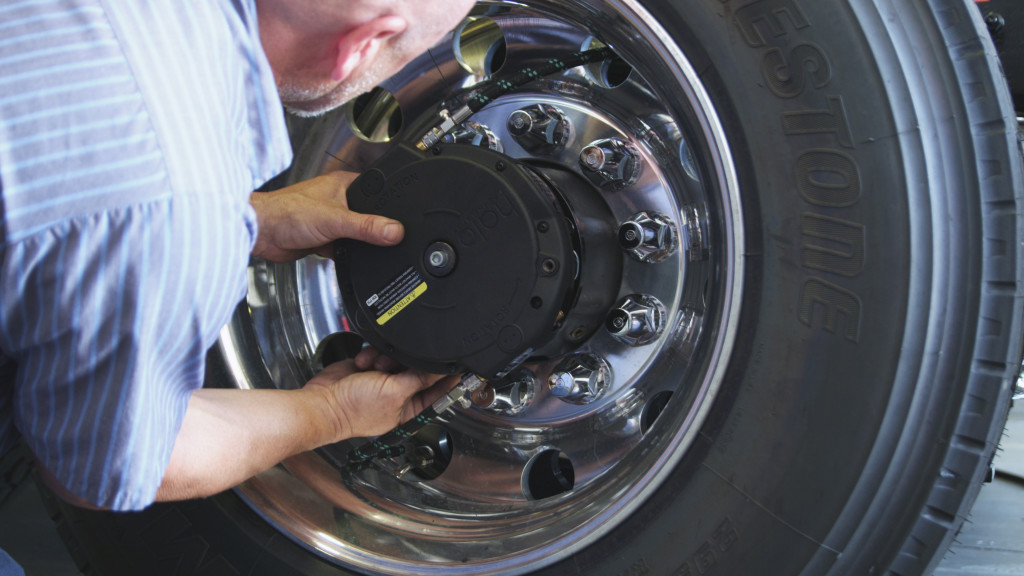Tires are getting smarter
Tires represent a fleet’s third largest expense, after fuel and driver wages, but they often don’t get the attention they deserve. Trey Thompson, field engineering manager with Continental, said industry studies have shown that 40-80% of commercial truck tires are at least 10% underinflated.
Just 10% underinflation increases fuel consumption by 2%, while reducing tread life by 15%. Just 20% underinflation is officially considered a flat tire.
“Unless your fleet is in the top echelon of tire maintenance, you’re going to be having more than half your tires costing you these unnecessary increases in your monthly budget,” said Thompson.
The good news is, tires are getting smarter. Thompson made the comments during the unveiling of a new line of “intelligent” construction tires, launched this fall. They come from the factory with sensors installed. The company followed that launch up with a regional steer tire that has the option of coming with the sensor.
There are various ways to access information communicated by the tire sensors. Continental offers an in-cab display, which notifies the driver when tire inflation is off. It also has a mobile app and a yard eeader, which captures tire inflation pressures as the trucks enter or leave a fleet’s yard. It’s well suited for fleets that return to base each night.
“We are proud to announce that in 2019, Continental has given the tire a voice,” Tom Fanning, vice-president of sales and marketing said while launching the Conti HSR3 steer tire at the North American Commercial Vehicle Show (NACVS). “We now communicate information from the tire into the truck and outside the truck.”
He also shared results of a case study, in which a U.S. fleet reduced its tire-related emergency road service costs from six cents per mile, to two cents per mile, after installing tire sensors and a yard reader.
One of the biggest issues that cause failures, is improper inflation pressures. Often, they’re not even correct to begin with.
“There are still some things we do, just because that’s what we always did, and tire inflation is one of those things,” Thompson said. He said many fleets simply fill the tires to 100 psi, which in the past was fine, as tires tended not to last long anyways. Since tire design has greatly increased removal miles, irregular wear now shows up long before the end of the tire’s intended life.
Phillip Mosier, manager, commercial tire development, with Cooper Tires, agreed.
“There is a large number of fleets that use 100 psi all the way around,” he told Truck News in an interview. “That’s the easiest thing for maintenance guys, is to remember one number. You really need to be paying attention to what the max load is, and adjusting pressure.”
“That’s the biggest problem in the fleet community – getting the right air pressure for the load,” added Jason Miller, Cooper Tires’ national fleet channel sales manager. “If you’re running full and coming back empty, what’s the right inflation pressure?”
Every tire manufacturer publishes a load and inflation table in its tire guide, however Thompson said those are referenced too infrequently. And it wasn’t practical to adjust tire pressures on the fly to always remain within those recommended inflation pressures.
A new product from SAF-Holland, introduced at NACVS, looks to change that – on trailers, at least. The company’s SMAR-te Tire Pilot now offers dynamic tire inflation adjustments based on axle load. Working with tech company AKTV8 to design the brains of the system, SAF-Holland’s Tire Pilot Plus wheel-ends can now read axle weight. The tire manufacturer’s load and inflation recommendations are loaded to the software and the tires are kept at the right pressure for the load.
A tire on a loaded trailer may be inflated to 100 psi, but it may perform better at 70 psi when unloaded. SAF-Holland estimates tire life can be increased by as much as 10-20% using the system.

Technology can also be helpful for tracking tread depths. Goodyear’s Tire Optix, introduced last year, has collected data from more than a million tires. Nearly 15% of those inspected tires required one or more corrective actions regarding inflation pressure or tread wear conditions, Goodyear claims.
“Goodyear Tire Optix eliminates the need for manual collection and entry of tire data,” said Johnny McIntosh, general manager, services and solutions, commercial tires with Goodyear. “And fleets can view the tire information collected by Tire Optix in real time, enabling them to identify maintenance opportunities and immediately adjust their tire management programs, if needed.”
Aperia, whose Halo tire inflation pressure works on both trucks and tractors, using the power of a rotating wheel to create air pressure, has recently added a telematics element to its product. Halo Connect not only maintains inflation pressure in real time, it also provides asset tracking and offers other tire maintenance data, included info entered about tread depths and replacement details.

UPS has been testing the system and during NACVS, Aperia called up a unit that had a tire leaking at 16 psi per hour. The issue was spotted even when the tire’s pressure was still reaching 100 psi because of operational forces. The truck made it back to the shop for a repair.
Halo Connect uses machine learning – and algorithms that draw on about 1.6 billion kilometers of experience with tires – to identify tire-related issues before a simple pressure gauge ever could.
“There’s really a one plus one equals three value when you combine the inflation and the analytics,” said president and chief executive officer Josh Carter, noting how inflation issues can be addressed before casings are degraded. “We’ve seen fleets report a 90%-plus reduction in tire-related emergency roadside service since implementing Halo Connect.”
But while more intelligent tires and new technologies are making it easier for fleets to monitor tire conditions, many rely on the old method of manual tire checks. This drives Thompson nuts.
“Often times, we have a fleet that says ‘We don’t need any system to check tires. We check our tires every night.’ But who’s doing that tire check? It’s always the new guy. He has no experience. He doesn’t appreciate this and doesn’t understand that these tires are the second biggest expense this fleet is going to incur this month, next month, and the month after,” Thomspon said of the maintenance person most commonly relegated to doing nightly tire checks. He also said it’s fair to question how many drivers properly check inflation pressures using a tire gauge during their pre-trip inspections, especially inside duals, which are difficult to reach.
“Checking tires is not very effective, and not cheap,” he contended.
Have your say
This is a moderated forum. Comments will no longer be published unless they are accompanied by a first and last name and a verifiable email address. (Today's Trucking will not publish or share the email address.) Profane language and content deemed to be libelous, racist, or threatening in nature will not be published under any circumstances.